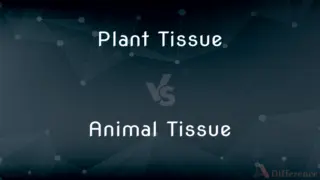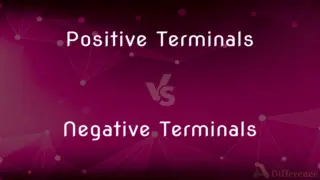Substitution Technique vs. Transposition Technique — What's the Difference?
By Tayyaba Rehman — Published on January 8, 2024
Substitution Technique involves replacing elements with others, like in ciphering. Transposition Technique rearranges elements or characters, maintaining their original identities, as in encryption methods.

Difference Between Substitution Technique and Transposition Technique
Table of Contents
ADVERTISEMENT
Key Differences
Substitution Technique is a cryptographic method that replaces elements with others, preserving their original identities. Transposition Technique, on the other hand, rearranges elements or characters without altering their identities, enhancing security in encryption.
In Substitution Technique, characters or elements are substituted with others according to a predefined rule or key. In contrast, Transposition Technique involves rearranging the order of characters or elements without changing their individual identities or values.
Substitution Technique, common in classic ciphers like the Caesar cipher, swaps characters with other characters based on specific rules or mappings. Transposition Technique, used in methods like columnar transposition, shuffles characters' positions without altering their values.
Substitution Technique alters the appearance or representation of characters by substituting them with others, preserving the characters' inherent values. Transposition Technique rearranges the sequence or positions of characters, maintaining their original identities while changing the order.
Comparison Chart
Operation
Replaces elements with others based on rules or mappings
Rearranges elements' positions without altering identities
ADVERTISEMENT
Impact on Elements
Substitutes elements, changing their representations
Rearranges positions, maintaining elements' original values
Examples
Caesar cipher, monoalphabetic substitution
Columnar transposition, route transposition
Character Alteration
Alters character representation through substitution
Changes character order while maintaining original values
Security Enhancement
Provides less security due to recognizable patterns
Enhances security by shuffling positions without changing values
Compare with Definitions
Substitution Technique
Swaps characters maintaining values.
Classic ciphers like monoalphabetic Substitution Techniques substitute characters without changing their inherent values.
Transposition Technique
Preserves element identities during rearrangement.
In encryption, Transposition Technique alters character positions while maintaining their original values.
Substitution Technique
Alters elements' appearances.
Substitution Technique transforms elements by substituting them with other predetermined symbols.
Transposition Technique
Enhances encryption by position shuffling.
Route transposition utilizes Transposition Technique, rearranging positions to bolster encryption strength.
Substitution Technique
Utilizes keys for element replacement.
Substitution Technique employs keys to substitute elements, altering their appearances.
Transposition Technique
Changes sequence without altering elements' values.
Transposition Technique rearranges elements without modifying their inherent characteristics.
Substitution Technique
Alters representations via substitution.
In cryptography, Substitution Technique changes characters using predetermined mappings.
Transposition Technique
Reshuffles element order for security.
Columnar transposition uses Transposition Technique to rearrange character positions to enhance encryption.
Substitution Technique
Replaces elements based on predefined rules.
The Caesar cipher uses a Substitution Technique to replace letters with others according to a specific shift.
Transposition Technique
Rearranges element positions without altering values.
Transposition Technique shuffles characters' positions without changing their inherent identities.
Common Curiosities
What is the primary function of Transposition Technique in encryption?
Transposition Technique reshuffles the positions of characters without altering their values, enhancing encryption security.
Can Substitution Technique provide strong encryption?
Substitution Technique might offer weaker encryption due to recognizable patterns resulting from direct character substitutions.
Is Substitution Technique easily recognizable in encrypted messages?
Yes, Substitution Technique can exhibit patterns, making it more susceptible to deciphering compared to Transposition Technique.
Can Substitution Technique alter the inherent values of elements?
Substitution Technique changes the appearance or representation of elements while maintaining their original values.
How does the Caesar cipher use Substitution Technique?
The Caesar cipher employs Substitution Technique by shifting characters by a predetermined number of positions in the alphabet.
What advantage does Transposition Technique offer over Substitution Technique?
Transposition Technique enhances security by rearranging character positions without directly substituting them, making it harder to decipher.
Does Transposition Technique alter characters' appearance in encryption?
Transposition Technique maintains characters' appearances but changes their sequence or positions to enhance encryption.
What risks are associated with using Substitution Technique in encryption?
Substitution Technique may pose risks due to recognizable patterns, making it more vulnerable to decryption attacks.
Can Substitution Technique be easily decrypted?
Substitution Technique might be easier to decrypt compared to Transposition Technique due to identifiable patterns resulting from direct substitutions.
Is Substitution Technique common in classical ciphers?
Yes, classical ciphers like the Caesar cipher frequently utilize Substitution Technique by replacing characters based on specific rules or mappings.
How does Substitution Technique differ from Transposition Technique in altering encrypted messages?
Substitution Technique changes the appearance of characters by direct replacement, whereas Transposition Technique rearranges character positions without altering their identities.
How does Transposition Technique maintain security in encryption?
Transposition Technique maintains security by rearranging character positions, obscuring the original sequence without altering the characters themselves.
Does Transposition Technique change characters' inherent values during encryption?
No, Transposition Technique rearranges characters' positions without altering their original values, preserving the integrity of the message.
How does Transposition Technique contribute to message security?
Transposition Technique enhances message security by reordering characters' positions, making it more challenging for unauthorized access.
Can Transposition Technique be combined with Substitution Technique for stronger encryption?
Yes, combining Transposition Technique and Substitution Technique can bolster encryption security by enhancing complexity and reducing patterns.
Share Your Discovery

Previous Comparison
Plant Tissue vs. Animal Tissue
Next Comparison
Positive Terminals vs. Negative TerminalsAuthor Spotlight
Written by
Tayyaba RehmanTayyaba Rehman is a distinguished writer, currently serving as a primary contributor to askdifference.com. As a researcher in semantics and etymology, Tayyaba's passion for the complexity of languages and their distinctions has found a perfect home on the platform. Tayyaba delves into the intricacies of language, distinguishing between commonly confused words and phrases, thereby providing clarity for readers worldwide.











































